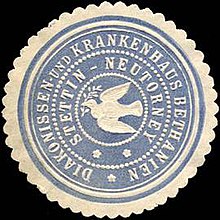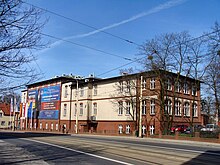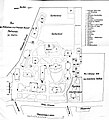Bethanien Deaconess and Hospital
The Bethanien Diakonissen- und Krankenhaus was a deaconess institution in Stettin that existed from 1869 to 1945 . From 1945 to 1992, most of the buildings in the spacious area served as the Soviet military hospital. Today the complex is a listed building and is used in different ways.
Surname
The name of this deaconess institution comes from the place Bethanien , where the leprous Simon von Bethanien lived, which is why the place is associated as a place of nursing, where Jesus of Nazareth stayed as Simon's guest (Gospel of Mark 14: 3–10). This name follows the Protestant tradition of naming newly established churches, religiously motivated foundations like other institutions, after events and places of activity in the life of Jesus .
history
1866 Founded in 1849 established Association for Inner Mission in Pomerania in New Torney (now Turzyn ) named after its founder Ernestine Krueger Ernestinenhof (today ul. Wawrzyniaka 8) on a plot Johannes Quistorp made available. The facility should provide shelter and shelter for maids . There was also a toddler school, a maid education school and a business pension . Emma Linden, a deaconess of the Kaiserswerther Diakonie took over the management, and there was a plan to add a deaconess and hospital.
This plan was realized in 1869. After numerous other foundations, Johannes Quistorp furnished the establishment to be founded in 1869 with a plot of 20 acres and a main building under construction on it. On October 13, 1869, the first seven deaconesses moved into the newly built house, and on the 1st of Advent, November 28, 1869, the Pomeranian superintendent Albert Sigismund Jaspis was able to carry out the inauguration. The newly built motherhouse on Alleestraße (today ul. Wawrzyniaka 7d - 7g), which was not completely finished until 1871, had space for 40 sisters, a nurses' room, a chapel and initially 40 sick people. The chapel, which could hold 400 people, also served as the parish church for the rapidly developing district of Neu Torney-Westend. The rectory was built at the same time as the main building.
In 1873 the establishment received the status of a corporation by royal decree, whereupon Johannes Quistorp assigned the properties to it with a deed of gift and donated several free beds. In 1883 Bethanien received parochial rights. It was led by the chaplain as headmaster and the superior, both of whom were responsible for the board of directors, which were made up of people from all over Pomerania . These included Carl Reinhold von Krassow , Lieutenant General von Heydebreck , the general superintendents Albert Sigismund Jaspis , Heinrich Poetter and Johannes Büchsel as well as Georg von Eisenhart-Rothe and Johannes Sarnow .
The first pastor was Friedrich Adolf Bramesfeld from Westphalia, first matron Emma Linden and first chief physician Dr. Kugler, he was followed from 1872 until his early death in 1886 by Dr. Emil mask. Pastor Julius Brandt and Oberin Philippine Mangelsdorff led Bethanien together for 38 years from 1871. The work grew steadily. Further houses were built on the site between Alleestraße and Kreckower Straße (today ul. Mickiewicza), first the large men's barracks during the Franco-Prussian War in 1871. In 1882 the women's and children's house was built to the left of the main building. In 1879 the area was enlarged by the purchase of the Quistorp nursery, where an isolation station was built. The former coach house was converted into a second men's station. After a fire in 1888, the attic of the main house was converted into nurses' rooms. A central steam laundry room was built in 1891 , and a new operation building in 1893. The buildings, mostly made of brick , were spread over the wide area in a pavilion style .
In 1893 the sisters received a rest home in Heringsdorf , the Elim house, on a piece of land donated by Ludwig Delbrück . In 1904, the main house was a wing as Feierabendhaus be served, expanded at the same time was a hallway, and the chapel was enlarged.
In 1893, 1818 patients were cared for on 54,245 days. Fields of work emerged all over Pomerania and beyond, and in 1893 250 deaconesses worked in Bethanien and at 70 different stations, primarily as parish nurses, in the entire province of Pomerania , in the province of West Prussia and in both Mecklenburg . By 1919 there were 113 locations with 362 nurses. The largest group with 20 sisters outside the parent company worked at the University Clinic in Greifswald .
In 1911 Bethanien had 450 sisters. After the First World War, the sisterhood's previously rapid growth declined. In 1919 there were 428, in 1929 460 and in 1932 437 sisters.
The hospital grew to 220 beds. During the First World War, the large men's barracks again served as a military hospital , where almost 4,000 wounded and sick soldiers were cared for by 1919. In 1918 2479 civilian patients were treated. In 1917, Martin Quistorp made it possible for the sisterhood to purchase a recreation facility in the mountains near Oberschreiberhau (today Szklarska Poręba ) in the Giant Mountains , which was called the Haus am Rabenstein .
On October 1, 1919, Bethanien acquired the adjacent Tivoli entertainment venue and Charlottental Society House . After it was completely demolished and rebuilt, it became a seminar and education center until 1928. In 1929 a marble bust of Martin Quistorp was placed in front of the main building (at today's ul. Wawrzyniaka) , who, like his father , had sponsored the deaconess hospital and died here on June 6, 1929.
In the time of National Socialism , there was a strategy of repression against institutions of the Inner Mission in Pomerania on a broad front . The Lyceum Freidenhof , supported by the Deaconess House and on the other side of Alleestrasse, was closed in 1937 at the instigation of the school council. There was increasing pressure from the authorities, brown sisters of the NSA instead of the deaconesses to deal with. In early April 1938, all contracts that deaconesses in Rotkreuz - day care centers and nursing stations were working terminated.
When the front moved back to Stettin in April 1945 towards the end of the Second World War, the hospital was evacuated. Approx. 80 deaconesses died when they came into Soviet fire while trying to cross the Oder .
After 1945
After the Red Army captured Szczecin on April 26, 1945 , the Soviet military administration confiscated the entire site. She kept it when she turned Szczecin over to Poland on July 5, 1945 , and set up a military hospital in most of the buildings , which lasted until 1992.
A German school was set up in house 7 and existed here until 1951. In 1949 the house of culture opened in house 8, the former men's ward, for the Germans who remained in Stettin. After the handover of this part of the site from the Soviet military administration to the Polish city administration, the latter initially closed the cultural center. On April 25, 1953, however, it was reopened, now under the responsibility of the Polish trade union, as the cultural center of the German-Polish Friendship Trade Unions . In addition to a large library, there were Polish language courses and groups for amateur play, singing, music, dance, chess, football, table tennis and gymnastics. After the wave of emigration in 1957, when over half of the Germans still living in Stettin left for Germany, it was used less and by other ethnic groups and closed in 1964.
After the Soviet military withdrew in 1992, different uses and ownership structures developed. The buildings are currently used by the School of European Integration, the University of Szczecin , the Contrasts Student Cultural Center , private primary schools and the Garrison Club.
The surviving deaconesses came to Western Pomerania in 1945 and found new tasks here in the Bugenhagenstift in Quistorp's home town of Ducherow , in Züssow , where a new diaconal institution was established, and in the Johanna Odebrecht Foundation in Greifswald . A Bethanien hospital was established there in 1947 , which until 1988 belonged to the Diakoniewerk in Ducherow. Some sisters found a new sphere of activity in the Evangelical Johannesstift Berlin .
Ducherow became the seat of the Diakonissenanstalt Bethanien until it was merged with the Bugenhagenstift in 1980 in the Evangelical Diakoniewerk Bethanien Ducherow . Today the "Evangelische Diakoniewerk Bethanien Ducherow" operates dormitories for people with disabilities in Ducherow, workshops for disabled people in Ducherow, Anklam, Heringsdorf and Zirchow, as well as a retirement home in Ducherow. The former rest home of the Deaconesses Haus Elim in Heringsdorf, which served as an old people's home from 1945 to 2002, is now a house for assisted living for people with mental illness, sponsored by the Diakoniewerk Ducherow.
people
Superiors
- 1869–1873 Emma Linden
- 1873–1910 Philippine Mangelsdorff (* July 21, 1831 in Prenzlau; † April 15, 1910 in Stettin)
- 1910–1930 Valesca von Unruh
- 1930–1954 Jutta Poetter (* July 11, 1881; † March 23, 1969 in Ducherow)
from 1945 in Ducherow
- 1954–1965 Christel Wentzlaff
- 1965–1970 Elisabeth Rehfeld (substitute)
- 1970–1979 Käthe Glöckner
- 1979–1983 Ruth Kiene
Chief
- 1869–1871 Friedrich Adolf Bramesfeld (born May 3, 1833 in Elberfeld ; † December 25, 1903 in Münster)
- 1871–1909 Julius Brandt (born January 24, 1826 in Treptow an der Rega ; † July 11, 1910 in Stettin)
- 1909–1927 Johannes Saltzwedel († 1929)
- 1927–1949 Ernst Poetter (born August 14, 1876 in Minden ; † June 18, 1961 in Ducherow)
from 1945 in Ducherow
- 1949–1977 Friedrich-Wilhelm Steinke
- 1977-2003 Harald Martin
- 2003–2004 Hans-Peter Göll
- 2005-2014 Martin Wilhelm
- 2015- Kai Becker
Chief physicians
- Dr. Kugler
- Dr. Emil Mask († October 30, 1886)
- 1887–1896 Dr. Hans Schmid († November 17, 1896 as a result of blood poisoning )
- 1897–1902 Prof. Haeckel
- 1902–1919 Dr. Carl Ossent († April 25, 1919)
- Dr. Kurt Lichtenauer
- Prof. Adolf Kahlstorf
building
- Main house (1866–1871) - ul. Wawrzyniaka 7e, 7f, 7 g, 7d
- Rectory (1869–1871) - ul. Wawrzyniaka 7
- Men's barracks (1871) - ul.Wawrzyniaka 6b - l
- Women's ward (1882) - 45 Mickiewicza Street
- House of Lords (1890) - ul.Wawrzyniaka 6
- Operating theater (1893) - ul.Mickiewicza 49
- Men's ward ( mansion ) (1893–1895) - ul. Wawrzyniaka 7b
- New men's ward (1902) - ul.Wawrzyniaka 7a
- Isolation ward for patients with diphtheria and scarlet fever (1905) - ul.Mickiewicza 55
- Women's Refuge (1906) - ul.Mickiewicza 47
- X-ray department and medical center (1911) - ul. Wawrzyniaka 7c
- Seminar and school building - ul.Wawrzyniaka 5
graveyard
The first deaconess died of typhus in 1870 while serving in the Franco-German War . She was the first to be buried in the sister cemetery, which was laid out in the middle of the prison garden. In 1891 it was enlarged and in 1895 a small chapel was added. In addition to sisters and employees, patients also found their final resting place in the cemetery. Johannes Quistorp and his son Martin were also buried here.
Evangelical family friend
As early as the after-celebration of the inauguration in 1869, members of the Provincial Synod and Friends of the Inner Mission decided to publish a Sunday paper, the proceeds of which were intended for the work of the Bethanien Deaconess and Hospital. It was published on January 1, 1870 under the title Evangelischer Hausfreund für Pommern .
plans
literature
- [Hans Meinhof]: The Bethanien Deaconess and Hospital in Neu-Torney, Stettin in the first 25 years of its existence. Memorandum for the 1st Advent in 1894. [Stettin] 1894 (pictures from church life and Christian charity in Pomerania 1)
- Johannes Saltzwedel: 50 years Protestant female Diakonie in Pomerania: 1869–1919; For the fiftieth anniversary of the Protestant Diakonissenanstalt "Bethanien" in Stettin-Neutorney. Stettin: Gentzensohn 1919
- Renate Jachow: Work and free time in Bethanien - House 8: House of Culture of German-Polish Friendship from 1949 to 1957. Kiel: Historical Working Group Stettin 2003 (On the life of Germans in Stettin after World War II; part 4 / Stettin issue 11)
- Encyklopedia Szczecina, Tom I , Uniwersytet Szczeciński, Szczecin 1999, ISBN 83-87341-45-2
- Marek Łuczak , Szczecin Pogodno Łękno, Pomorskie Towarzystwo Historyczne, Szczecin 2009, ISBN 978-83-751817-6-0
Web links
Individual evidence
- ↑ FS 1894, p. 5
- ↑ FS 1919, p. 43
- ↑ FS 1894, p. 16
- ↑ FS 1894 (Lit.), p. 1
- ↑ A complete overview of the locations from 1919 can be found in FS 1919 (Lit.), pp. 30–34
- ↑ Table of the numbers of nurses up to 1919 in FS 1919 (Lit.), p. 42; see also Werner Klän: The Protestant Church of Pomerania in Republic and Dictatorship: History and Design of a Prussian Church Province 1914–1945. Cologne; Weimar; Vienna: Böhlau 1995 (Zugl .: Münster (Westphalia), Univ., Habil.-Schr., 1993) ISBN 3-412-04195-5 , p. 125
- ↑ FS 1919 (lit.), p. 26
- ↑ See the table of patient numbers from 1869 to 1919 in FS 1919 (Lit.), p. 28
- ↑ Werner Klän: The Protestant Church of Pomerania in Republic and Dictatorship: History and Design of a Prussian Church Province 1914–1945. Cologne; Weimar; Vienna: Böhlau 1995 (Zugl .: Münster (Westphalia), Univ., Habil.-Schr., 1993) ISBN 3-412-04195-5 , p. 527 f
- ↑ Werner Klän: The Protestant Church of Pomerania in Republic and Dictatorship: History and Design of a Prussian Church Province 1914–1945. Cologne; Weimar; Vienna: Böhlau 1995 (Zugl .: Münster (Westphalia), Univ., Habil.-Schr., 1993) ISBN 3-412-04195-5 , p. 528
- ^ Friedrich Bartels: The Inner Mission in Pomerania in the 19th and 20th centuries. Their roots - their developments - their changes. ( Memento of March 7, 2014 in the Internet Archive ), accessed June 24, 2014
- ↑ Jachow (lit.), p. 16
- ↑ Harald Martin: Pictures on the history of the Evangelical Diakoniewerk Bethanien Ducherow for the period from 1865 to 2003. Neuss: Bongartz [2005], p. 32
- ↑ See preamble to the statutes of the Evangelical Diakoniewerk Bethanien Ducherow ( Memento from May 9, 2014 in the Internet Archive ): The foundations “Bugenhagenstift Ducherow” (1866) and “Evangelische Diakonissenanstalt Bethanien Stettin-Neutorney” (1869) have each other in accordance with the statutes of February 25, 1980, merged to form a joint foundation called "Evangelisches Diakoniewerk Bethanien in Ducherow". This foundation is the legal successor of the two foundations mentioned.
- ↑ Homes
- ↑ Names and dates according to Harald Martin: Pictures for the history of the Evangelical Diakoniewerk Bethanien Ducherow for the period from 1865 to 2003. Neuss: Bongartz [2005], p. 33
- ↑ Entry in the Rostock matriculation portal
Coordinates: 53 ° 26 ′ 19 ″ N , 14 ° 31 ′ 45.9 ″ E






















